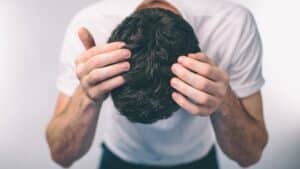Female pattern baldness, also known as androgenetic alopecia, is a common hair loss condition that affects millions of women worldwide. It is characterized by thinning hair and a receding hairline, often leading to complete baldness due to hair follicle shrink and fallout.
This type of hair loss is caused by a combination of genetics and hormonal factors, making it difficult to prevent or reverse. However, there are various treatments available that can help slow down or even stop the progression of female pattern baldness.
From medication to laser therapy and hair transplant procedures, there are options for every individual’s needs. In this article, we will explore the causes of female pattern baldness and discuss effective ways to combat it. So, if you’re wondering how to stop female pattern baldness, keep reading for more information.
What is Female Pattern Baldness?

Female pattern baldness is a type of hair loss condition that affects women, characterized by thinning hair and a receding hairline. In simple terms, it is the female version of male pattern hair loss. It is also known as androgenetic alopecia, and it is the most common cause of hair loss in women. This condition can start as early as puberty or later in life, but it usually becomes more noticeable after menopause.
The main cause of female pattern baldness is a combination of genetics and hormones. Women with a family history of this condition are more likely to experience it themselves because they inherit the genes responsible for male or female pattern baldness from their parents. Hormones also play a significant role in this type of hair loss, specifically dihydrotestosterone (DHT), which causes miniaturization of hair follicles, leading to thinner and weaker hair growth.
What Causes Female Pattern Baldness?
Female pattern baldness, or androgenetic alopecia, is primarily caused by a combination of genetics and hormones. In simpler terms, if you have family members who have experienced hair loss, you are more likely to develop it yourself. This condition is hereditary and can be passed down from either the mother or father’s side of the family. However, this does not guarantee that you will experience female pattern baldness; it simply means that your risk is higher than those without a family history.
Aside from genetics, hormonal factors also play a significant role in female pattern baldness. Testosterone, a male hormone present in both men and women, can convert to dihydrotestosterone (DHT) through an enzyme called 5-alpha-reductase. DHT is the main culprit behind hair loss in male and female pattern baldness, as it can shrink hair follicles, leading to thinner and weaker hair growth.
Hormonal imbalances, such as those caused by menopause or polycystic ovary syndrome (PCOS), can also contribute to female pattern baldness. As these conditions affect hormone levels in the body, they can disrupt the hair growth cycle and cause excessive hair shedding. Additionally, certain medications that impact hormone levels can also trigger female pattern baldness in some individuals.
How Can I Stop Female Pattern Baldness?
Medications: Aside from the mentioned treatments, there are also medications available for treating female pattern baldness. Minoxidil, commonly known as Rogaine, is a topical solution that can be directly applied to the scalp.
It was initially developed to treat high blood pressure but has shown unexpected hair growth effects. However, it may take at least two months before any significant results and needs to be used continuously to maintain hair growth.
Anti-androgens like spironolactone are also prescribed to block excessive testosterone production and hormones that contribute to hair loss in women with conditions like PCOS. While these medications may provide some relief, they do come with potential side effects like weight gain and loss of libido.
Nutritional Deficiencies: Nutritional deficiencies such as low iron levels or vitamin B12 deficiency can also contribute to hair loss. Vegans and vegetarians can be particularly susceptible to these deficiencies because these nutrients are primarily found in animal products.
A blood test may be ordered to determine if nutrient deficiencies are the cause. Heavy metal toxicity is another culprit, which can block the absorption of essential nutrients needed for healthy hair growth. A blood test can be conducted to test for heavy metals as well.
Laser Hair Restoration Devices: In addition to the mentioned treatments, there are also laser hair restoration devices available for those who want a non-invasive and drug-free option. Low-level light therapy (LLLT) has been shown to stimulate hair growth by increasing circulation and promoting cell renewal in the scalp. This can help dormant hair follicles start producing new, healthier strands of hair.Some popular LLLT devices include handheld combs or caps that use red light therapy to promote hair growth. These devices are painless and only require a few minutes of treatment per day at home. However, it’s essential to note that results may vary, and consistent use is necessary for optimal results.
What are the stages of female pattern baldness?
Stage 1: At this stage, there may be a slight widening of the part or thinning of hair on the top of the scalp. Hair loss is not noticeable and can still be easily concealed with hairstyles or hair products.
Stage 2: At this stage, significant thinning can be observed on the top of the scalp. The hairline may also start to recede slightly.
Stage 3: At this stage, there is a visible decrease in hair density on the entire top of the scalp. The hairline becomes more noticeably receded. This stage is when most women seek treatment for their female pattern baldness.
Stage 4: At this stage, hair loss becomes more severe, with a significant decrease in hair density on the top of the scalp. The receding hairline may be more pronounced and start to form an “M” shape.
Stage 5: At this final stage, there is a considerable amount of hair loss on the top of the scalp, and thinned areas may start to merge, leaving only sparse hair coverage. The receding hairline may now appear more like a horseshoe shape.
Can you reverse female pattern baldness?
While there is no cure for female pattern baldness, the progression of hair loss can be slowed or even reversed with proper treatment. It’s important to note that results may vary and will depend on individual factors such as genetics, hormone levels, and overall health. Here are some potential ways to reverse female pattern baldness:
Early Treatment:
One of the most effective ways to reverse female pattern baldness is to seek treatment as early as possible. As with many health conditions, early detection and intervention can make a significant difference in the success of treatment. In the case of female pattern baldness, this means identifying signs of hair loss and seeking medical advice before it progresses to more severe stages.
Early treatment of hair loss may include medication such as minoxidil or anti-androgens, which have been shown to effectively slow down or even reverse hair loss in some individuals. Doctors may also recommend dietary changes or supplements to address any nutritional deficiencies that may be contributing to hair loss.
Consistent Use of Medications:
Another key factor in reversing female pattern baldness is the consistent use of medications. As mentioned earlier, minoxidil and anti-androgens need to be used continuously to see results. This means following the prescribed dosage and application instructions as directed by a doctor or dermatologist.
Skipping doses or not using the medication consistently can significantly decrease its effectiveness and may even lead to further hair loss. It’s essential to understand that these medications are not a quick fix and require patience and dedication for long-term results.
Address Underlying Health Issues:
Addressing underlying health issues is another crucial aspect of reversing female pattern baldness. As mentioned earlier, conditions like PCOS, thyroid disorders, or nutrient deficiencies can contribute to hair loss. By addressing and managing these underlying health issues, hair growth may be restored.
For example, treating an overproduction of male hormones in women with PCOS through medication or lifestyle changes can help reduce hair loss and stimulate hair growth. Similarly, correcting any nutritional deficiencies can also have a significant impact on the health of hair follicles.
Hair Transplantation:

Hair transplantation is a surgical procedure that involves taking hair follicles from one part of the body and grafting them onto areas with thinning or balding hair. It has been predominantly used as a solution for male pattern baldness, but it is also becoming an increasingly popular option for women with female pattern baldness.
While other treatments may slow down or even reverse hair loss, they are not considered permanent solutions. Hair transplantation, on the other hand, can provide long-lasting results by restoring natural-looking hair growth in areas that have experienced significant hair loss.
What are the symptoms of female pattern baldness?
The most common symptoms of female pattern baldness include:
Thinning of hair on the top of the scalp
A receding hairline, usually starting at the temples
Widening of the part or visible scalp when hair is pulled back
Noticeable decrease in hair density and volume
Visible sparse areas on the scalp where hair follicles have stopped producing new hairs.
Other less common symptoms may include itching, tingling, or discomfort on the scalp. However, these symptoms may also be indicative of other underlying conditions and should be discussed with a medical professional for proper diagnosis.
Male-pattern baldness in women (AKA female pattern hair loss)
Although male-pattern baldness (androgenetic alopecia) is typically associated with men, it can also affect women. This condition causes a gradual thinning of hair on the top of the scalp and can lead to complete baldness in some cases. Male-pattern baldness in women is caused by similar factors as female-pattern baldness, including genetics, hormonal imbalances, and aging.
However, it may also be a result of certain medical conditions or medications. Treatment options for male-pattern baldness in women are similar to those for treating female pattern baldness and should be discussed with a medical professional.
What is the difference between telogen effluvium and female pattern baldness?

Telogen effluvium and female pattern baldness are two distinct types of hair loss that affect women. Here are the main differences between the two:
Causes:
Telogen effluvium is a type of hair loss that occurs when the body experiences a significant stressor, such as physical trauma, illness, or major hormonal changes. This stress causes a large number of hair follicles to enter the resting phase (telogen) and shed at once. Telogen effluvium is typically temporary and reversible once the underlying cause is addressed.
On the other hand, female pattern baldness is caused by a combination of genetic predisposition and hormonal imbalances. In women with this condition, an enzyme called 5-alpha reductase converts testosterone into dihydrotestosterone (DHT), which can shrink hair follicles and lead to thinner hair.
Pattern of Hair Loss:
In telogen effluvium, hair loss tends to occur in a diffuse pattern all over the scalp. This means that the hair loss is spread out and not concentrated in one specific area. It can also happen suddenly, with large amounts of hair falling out at once.
In contrast, female pattern baldness typically follows a distinct pattern known as diffuse hair loss begins at the crown or top of the head and gradually spreads outward, leaving a noticeable thinning of hair on the top of the scalp. It may also involve a receding hairline at the temples.
Reversibility:
One of the key differences between telogen effluvium and female pattern baldness is the reversibility of hair loss. As mentioned earlier, telogen effluvium is typically temporary and reversible once the underlying cause is addressed. This means that once the body has recovered from a stressor or hormonal imbalance, hair can regrow.
In contrast, female pattern baldness is considered a permanent condition. The degree of hair thinning can be slowed down or even reversed through treatments such as medications or lifestyle changes, but it cannot be fully cured. Hair growth may also vary in individuals with this condition, with some experiencing more regrowth than others.
Diagnosis:
Diagnosing female pattern baldness involves a combination of physical examination, medical history, and diagnostic tests. During a physical exam, the doctor will look for signs of hair thinning and loss, as well as any other associated symptoms.
The doctor may also ask about family history of hair loss and any underlying health conditions that could contribute to hair loss. This information can help determine if female pattern hair loss or if there are other contributing factors.
How To Reverse Female Hair Loss?
There are various methods for reversing female hair loss, and the best approach will depend on individual factors such as the stage of hair loss and underlying causes. Here are some general tips that may help reverse female hair loss:
Maintain a Healthy Diet:
A balanced and nutritious diet is essential for overall health, including hair health. Certain nutrients like protein, iron, and vitamins A, C, and D are particularly important for promoting healthy hair growth. Consuming foods rich in these nutrients can help reverse male pattern hair loss and improve the overall appearance of hair.
For example, increasing intake of lean proteins such as chicken, fish, eggs, legumes, and nuts can provide amino acids necessary for hair growth. Foods high in iron like spinach, kale, lentils, and red meat can prevent anemia-induced hair loss. Vitamin A can be found in sweet potatoes, carrots, eggs, and dairy products to promote sebum production which protects the scalp.
Reduce Stress:
Stress can have a significant impact on hair health and contribute to female hair loss. Psychological stressors, such as work or personal life stress, can cause the body to produce high levels of the hormone cortisol, which can disrupt the natural hair growth cycle. This disruption can lead to increased shedding and thinning of hair.
To reduce stress levels, it is important to identify sources of stress and find healthy coping mechanisms. Engaging in relaxation techniques such as meditation, deep breathing exercises, or yoga can help lower cortisol levels and promote overall well-being.
Use Hair Growth Products:
Another way to potentially reverse female hair loss is by using hair growth products. These can include over-the-counter supplements, topical medications, and specialized shampoos or conditioners.
Some hair growth supplements contain vitamins, minerals, and herbs that claim to promote healthy hair growth. While there is limited scientific evidence to support their effectiveness, some people may experience positive results from using these products.
Can you reverse female-pattern baldness?
If you are experiencing hair loss, it is essential to consult with a medical professional for an accurate diagnosis and personalized treatment plan. This is especially important if the hair loss is sudden, severe, or accompanied by other symptoms.
A doctor will be able to determine the underlying cause of your hair loss and provide appropriate treatment options. They may also refer you to a dermatologist or hair shaft for further evaluation.
While female pattern baldness cannot be fully reversed, it can be managed and slowed down with proper treatment. Consistent use of medications, addressing underlying health issues, and maintaining a healthy lifestyle can all contribute to reducing hair loss and promoting regrowth in women with this condition.
It’s important to remember that results may vary for each individual, so consult with a medical professional for personalized treatment recommendations. Overall, while there is no definitive cure for female pattern baldness, there are many options available to help manage and improve the condition. So don’t lose hope – take action and work towards healthier, fuller hair!
FAQs
How to stop hair loss and regrow hair naturally for female?
Some natural remedies that may help prevent lost hair and promote hair regrowth for females include massaging the scalp with essential oils, consuming a diet rich in nutrients, avoiding tight hairstyles, and reducing stress levels.
Which vitamin deficiency causes hair loss?
Vitamin D deficiency has been linked to hair loss in some studies, although more research is needed to confirm the connection. Other deficiencies that may contribute to hair loss include iron, biotin, and zinc.
What age does female pattern baldness start?
Female pattern baldness can start as early as the teenage years, but it is most common in women over the age of 40. It tends to become more prevalent with age, and up to 50% of women over 65 may experience some degree of hair loss.

